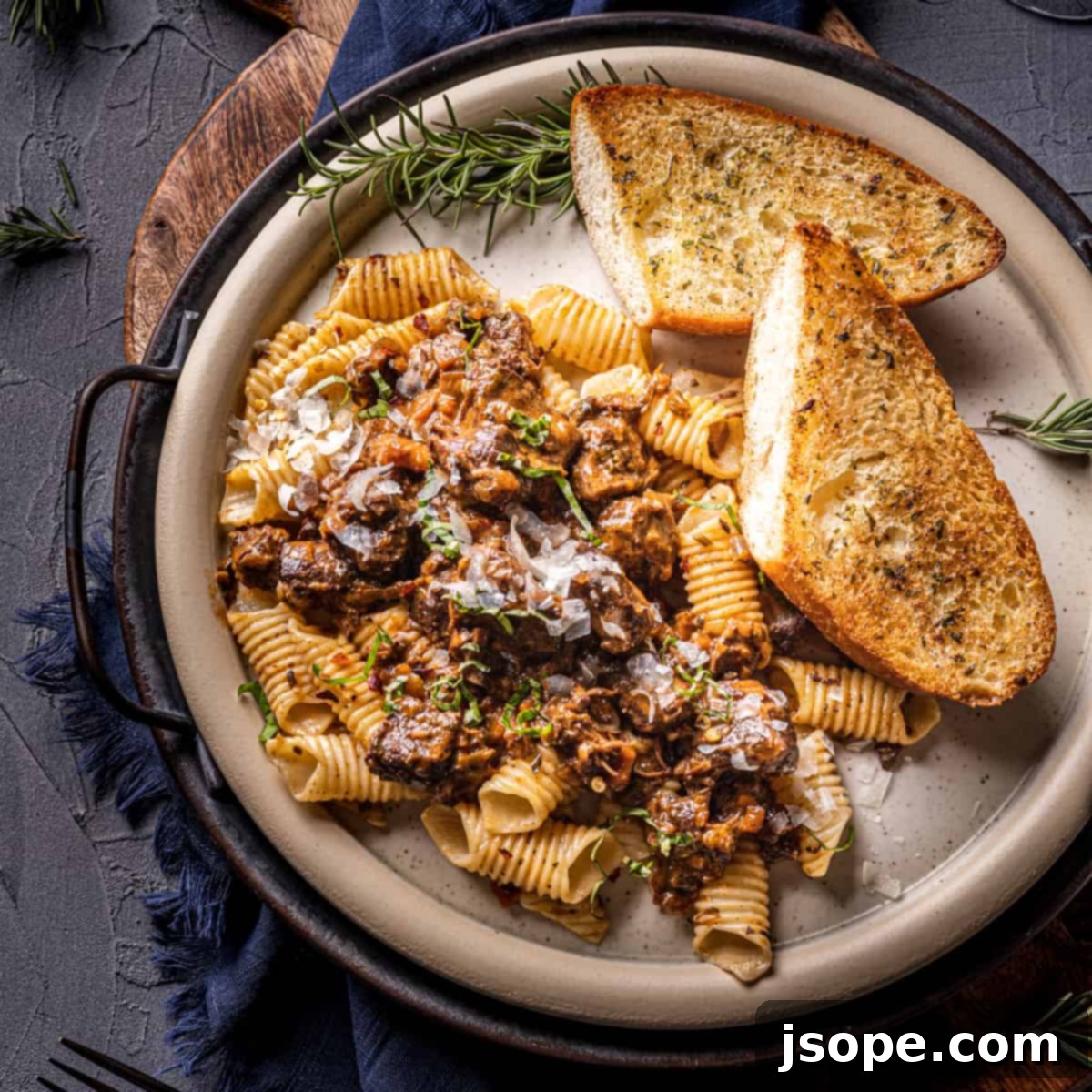There are few culinary delights as profoundly satisfying and soul-warming as a rich, slow-cooked ragù expertly paired with pasta. While some might consider this a mere opinion, we stand firm in our belief that a well-crafted ragù is the quintessential cool-weather dish, though its comforting embrace is welcome any time of year. Over the years, we’ve explored countless variations of this beloved Italian staple, each offering its own unique charm. Among these, our Pork and Shiitake Mushroom Ragù stands out as a particular favorite, especially as the crisp air of autumn begins to settle in. Yet, its deep, earthy flavors and tender textures make it a cherished meal no matter the season.
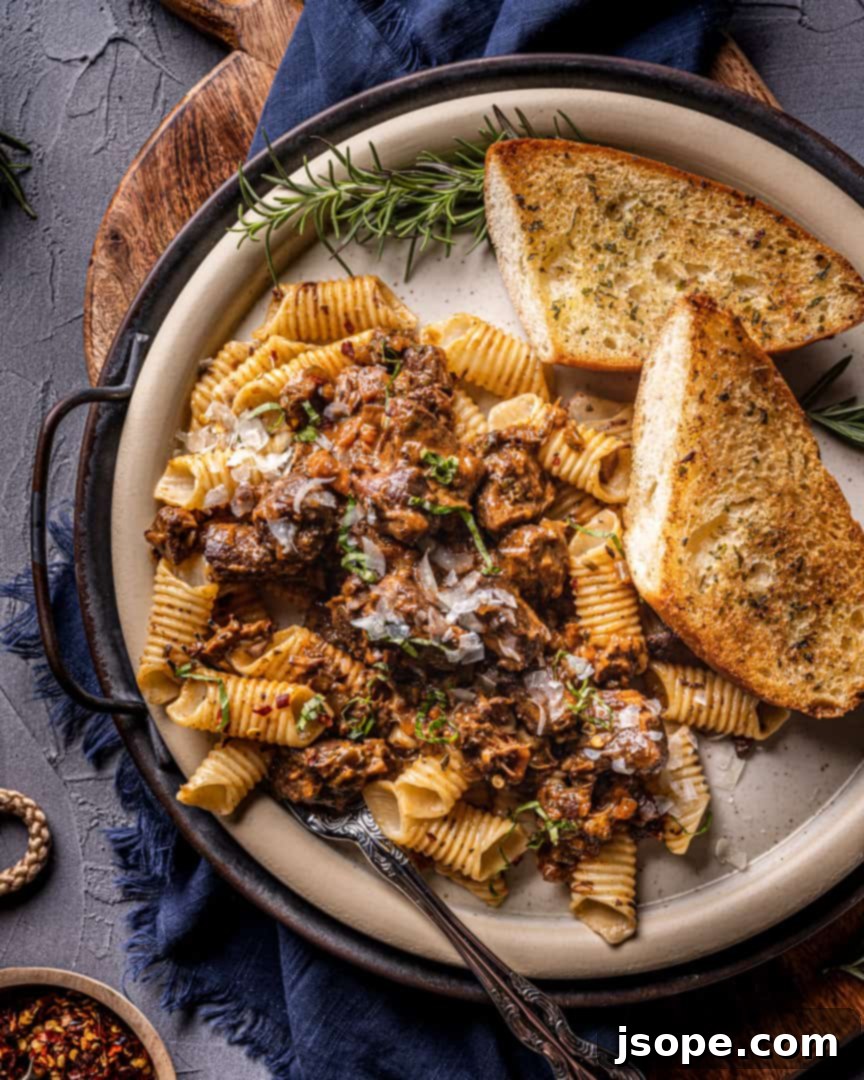
This Pork and Shiitake Mushroom Ragù isn’t just a meal; it’s an experience designed to envelop you in warmth and culinary bliss. It’s the perfect centerpiece for a cozy family dinner or a delightful gathering with friends, promising a symphony of flavors that will linger long after the last bite.
Unraveling the Mystery: What Exactly is Ragù?
The term “ragù” often conjures images of robust, slow-simmered meat sauces, and rightly so. At its heart, a ragù is a meat-based sauce, predominantly featuring meat, designed to be served with pasta. While some purists may adhere to very strict definitions, we believe the true spirit of ragù lies in its regional diversity and adaptability. Across Italy, from the bustling cities to the quietest villages, and even within individual households, the composition of ragù varies significantly. These delightful differences showcase the rich tapestry of Italian culinary traditions.
Fundamentally, a ragù distinguishes itself from a simple tomato sauce by its emphasis on meat. While tomatoes can be an ingredient, they typically play a supporting role, contributing acidity and depth rather than dominating the flavor profile. If your palate craves a more tomato-forward experience, we encourage you to explore our vibrant homemade marinara sauce. Beyond this distinction, the “rules” for ragù become delightfully flexible. You’ll find ragùs made with an array of meats – beef, pork, veal, lamb, game, or a combination – and cooked in various liquids, from red or white wine to broths, milk, or even water. Aromatic vegetables like soffritto (a foundational mix of onion, carrot, and celery) and fresh herbs are almost always integral, building complex layers of flavor over hours of gentle simmering.
Our approach to ragù embraces this spirit of tradition coupled with creative exploration. While we often craft meat-centric versions, we’ve also successfully developed delicious meatless mushroom ragùs that prove equally satisfying. The common thread in all our ragù recipes, however, is the commitment to a slow-cooking process, allowing the ingredients to meld and tenderize, often with wine as the primary cooking liquid, which imparts an unparalleled depth of flavor.
Ragù vs. Bolognese: A Common Culinary Conundrum
One of the most frequently asked questions in the world of Italian sauces revolves around the distinction between ragù and Bolognese. The answer, in essence, is quite simple: Bolognese is a specific type of ragù. Originating from the northern Italian city of Bologna, Ragù alla Bolognese adheres to a particular set of characteristics that make it unique among the broader category of ragùs.
Traditionally, a true Bolognese sauce is made with a combination of finely ground or minced beef and pork, often enriched with white wine and a small amount of milk or cream, along with a minimal touch of tomato paste. The cooking process is long and slow, resulting in an incredibly rich, thick, and velvety sauce that clings beautifully to wide, flat pasta like tagliatelle. It’s not a heavily tomato-laden sauce; the tomatoes serve primarily to deepen the savory notes of the meat, not to be the star ingredient.
In the United States, the term “Bolognese” is often applied to sauces that are much heavier on tomatoes, sometimes even resembling a chunky marinara. While these sauces can be delicious in their own right, they deviate significantly from the traditional Bolognese Angela experienced firsthand during her visit to Bologna in 2019. The people of Bologna are fiercely proud of their culinary heritage, especially when it comes to their pasta traditions. We share a deep respect for these authentic recipes. While we love to innovate and experiment with flavors in our ragùs, when it comes to a sauce bearing the name “Bolognese,” we believe in honoring its origins. Therefore, you won’t find drastically altered versions of “Bolognese” on our blog. Instead, we channel our creativity into the vast and diverse world of ragù, like the exceptional recipe we’re sharing today.
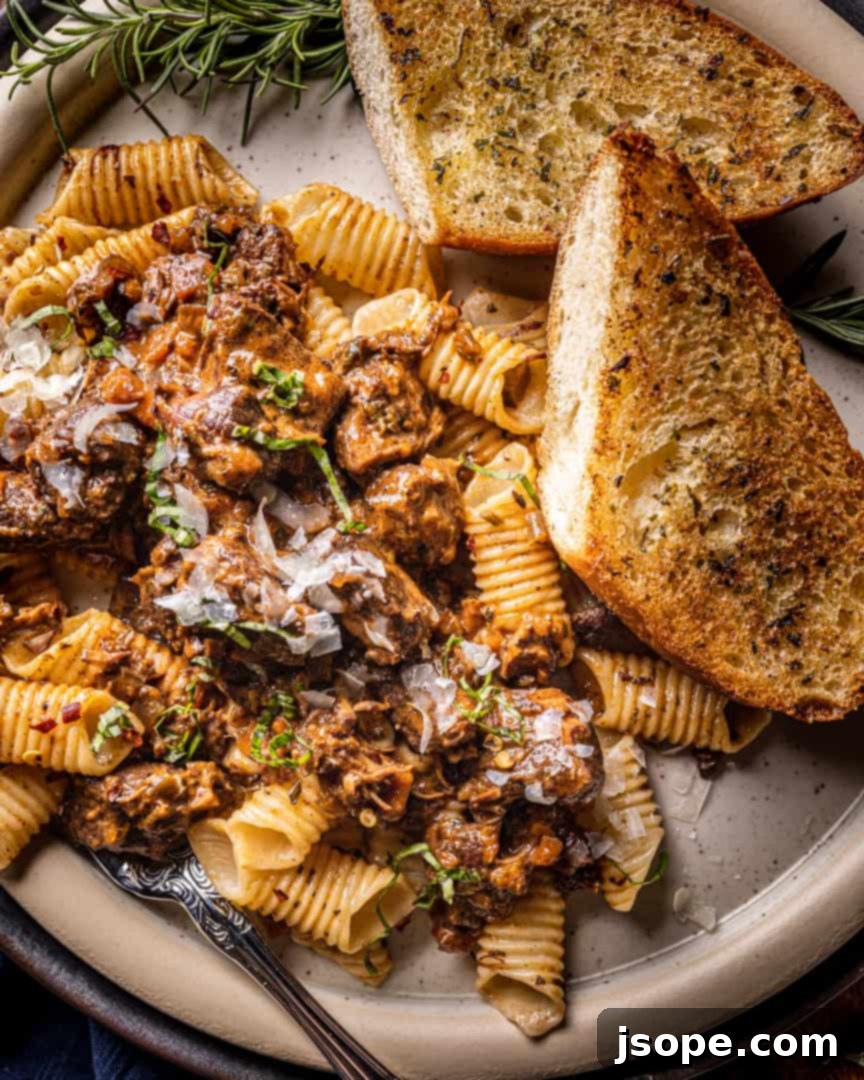
Highlighting Our Signature Pork and Shiitake Mushroom Ragù
Our Pork and Shiitake Mushroom Ragù is a testament to how innovative additions can elevate a classic dish. The inclusion of shiitake mushrooms might seem unconventional to some, but their unique flavor profile is truly transformative. Shiitakes are renowned for their deep umami and earthy notes, which act as a powerful flavor enhancer rather than a dominant ingredient. Many who taste this ragù might not immediately identify mushrooms, yet they undeniably contribute to the sauce’s extraordinary richness and complexity.
These mushrooms don’t overpower the robust pork; instead, they harmonize with it, adding a layer of savory depth that rounds out the entire dish. The subtle nuttiness and slightly woody undertones of the shiitakes create a more sophisticated and nuanced flavor experience. We’ve done the experimenting so you don’t have to: trust us when we say that adding shiitake mushrooms is the key to unlocking the elevated taste of this particular ragù. Their presence is a quiet masterpiece, enhancing every spoonful without demanding the spotlight.
The Art of the Cut: Does Pork Size Really Matter in Ragù?
When preparing ragù, the size and cut of your pork can significantly influence the final texture of your sauce. For our Pork and Shiitake Mushroom Ragù, we opt for pork cut into approximately ½-inch cubes or chunks. This choice ensures that the meat remains intact after hours of slow simmering, providing a satisfying, tender bite in every mouthful. This preferred “mouthfeel” adds a delightful textural contrast to the smooth, rich sauce, making each forkful an exciting experience.
However, culinary exploration is always encouraged! You have the freedom to adjust the cut size based on your personal preference. In some Northern Italian ragùs, ground proteins are commonly used, resulting in a sauce where the meat completely disintegrates and blends seamlessly into the sauce. If you desire a ragù with a consistently smooth texture, where the meat almost melts into the background, opt for smaller chunks or even minced pork.
Conversely, if you appreciate distinct, ultra-tender, and juicy pieces of meat that you can truly sink your teeth into, sticking with our recommended larger cuts is the way to go. The beauty of ragù lies in its versatility, allowing you to tailor it to your desired culinary experience. We wholeheartedly encourage you to experiment with different pork cuts in future preparations to discover which texture perfectly suits your taste buds.
The Finishing Touch: Elevating Your Ragù with Garnish
Garnish is far more than just a decorative element; it’s a vital component that brightens the final presentation and introduces a fresh burst of flavor and aroma. For our Pork and Shiitake Mushroom Ragù, we recommend a sprinkle of fresh basil leaves. While basil is not typically considered an autumn or winter herb, its vibrant color and peppery-sweet notes offer a delightful contrast to the rich, deep flavors of the slow-cooked sauce, and it’s readily available in most grocery stores year-round.
However, the world of herbs offers a multitude of possibilities for garnishing your ragù. Since this sauce is imbued with the warm, savory essence of various fall herbs during its cooking process, consider echoing those flavors or introducing new ones with your garnish. Freshly chopped parsley provides a bright, clean note and a beautiful green hue. Thyme offers a subtle earthiness, while a tiny sprinkle of finely chopped rosemary can add a fragrant, pine-like aroma. Even a hint of oregano can bring a rustic, savory touch.
Don’t hesitate to experiment with what’s fresh, in season, or simply what you have on hand. The goal of the garnish is to complement and enhance, providing a fresh counterpoint to the slow-cooked richness of the ragù. Discovering your preferred combination is part of the joy of cooking.
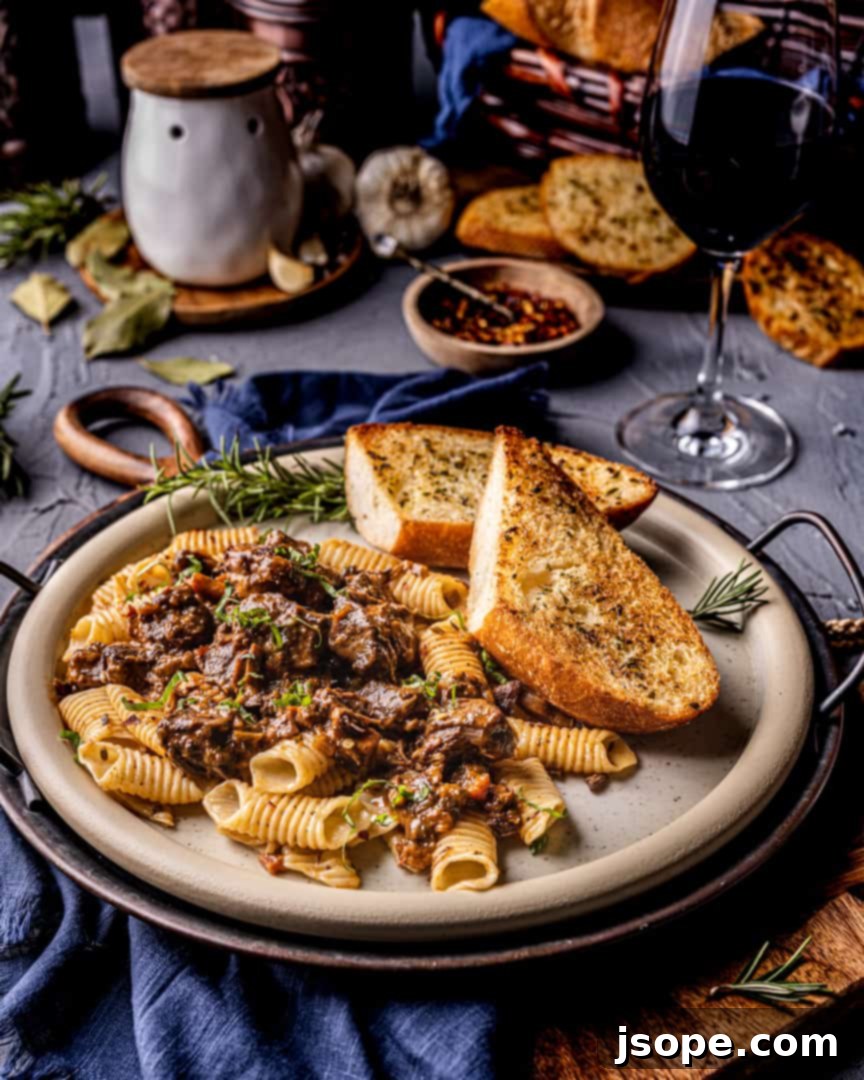
Choosing the Perfect Canvas: Which Pasta Best Complements This Ragù?
The pairing of pasta with sauce is an art form in itself, and while many hold strong opinions on what “should” or “should not” go together, we advocate for a more adventurous and personal approach. The truth is, pasta, in all its wondrous forms—from tender egg-yolk creations to robust eggless varieties—is inherently delicious. The true magic lies in how the pasta shape interacts with the sauce to create a harmonious “mouthfeel” and enhance your overall dining experience.
For a hearty, chunky sauce like our Pork and Shiitake Mushroom Ragù, the ideal pasta shapes are those designed to capture and hold every drop of that savory goodness. Look for shapes with ridges, folds, curves, or hollow centers. These textural elements act like tiny pockets and channels, allowing the rich ragù to cling beautifully and ensure that each bite delivers a perfect balance of pasta and sauce.
Some excellent choices include:
- Garganelli: Our personal choice for this recipe, hand-rolled from an eggless dough of Tipo 00 flour and semolina. Their distinctive ridges and hollow, quill-like shape are exceptional at cradling the ragù.
- Rigatoni or Penne: These tubular shapes, often with ridged exteriors, are classic choices for thick sauces. The ragù nestles perfectly within their hollow interiors, delivering a burst of flavor with every bite.
- Pappardelle or Tagliatelle: These wide, flat egg noodles are traditionally paired with rich ragùs. Their broad surface area allows the sauce to coat each strand generously, providing a luxurious mouthfeel.
- Cavatelli or Orecchiette: These shell-like or ear-shaped pastas are fantastic for scooping up chunky sauces, ensuring that you get a bit of meat, mushroom, and sauce in every spoonful.
For those inspired to create their own pasta from scratch, our multipurpose pasta dough recipe is an excellent starting point and works wonderfully with this ragù. If you’re passionate about homemade pasta, be sure to check out our Amazon Shop for all our favorite pasta-making gear!
Ultimately, the best pasta for your ragù is the one you enjoy most. Don’t be afraid to experiment with different shapes to discover new textures and experiences. Each pairing offers a unique journey for your palate.
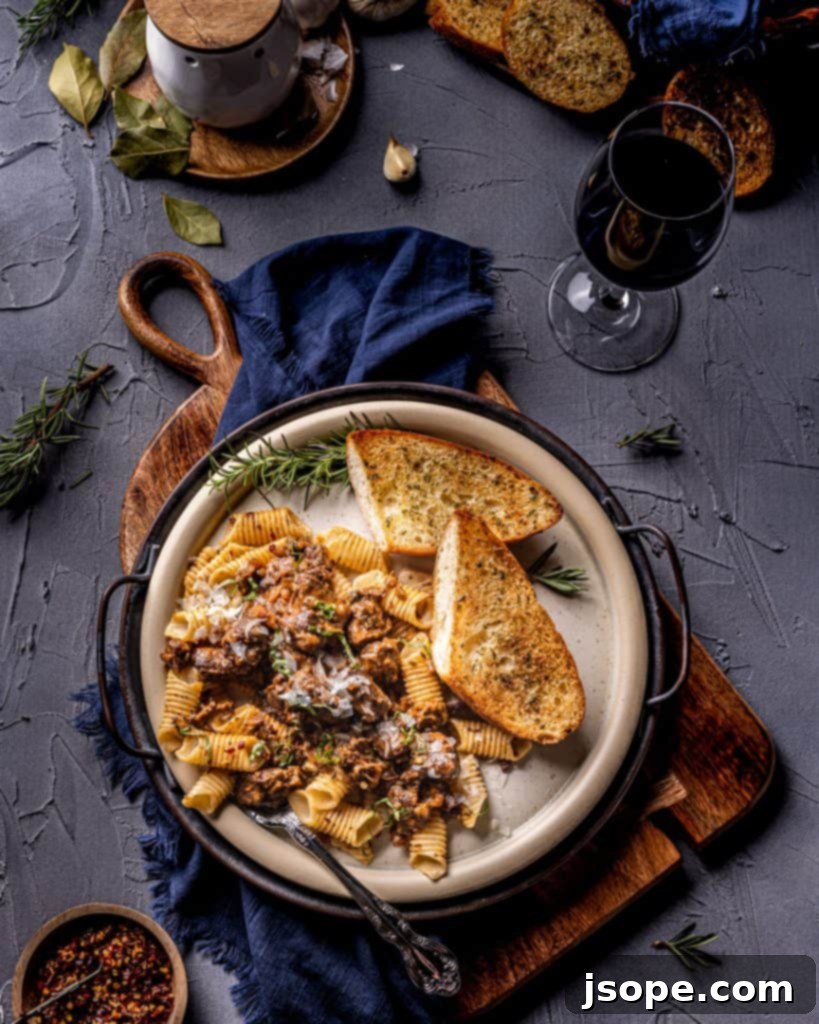
Savor Every Moment!
We genuinely hope you find as much joy in preparing and tasting our Pork and Shiitake Mushroom Ragù as we do. It’s a dish crafted with passion, designed to bring warmth and delight to your table. If you decide to embark on this culinary adventure, we would absolutely love to hear about your experience! Please feel free to leave us a comment below and share your thoughts. Even better, tag us on Instagram @cooking_with_wine so we can see your beautiful creations!
For those craving more pasta inspiration, we invite you to explore some of our other popular recipes:
- Pumpkin Ravioli with Parmesan Sage Cream Sauce
- Italian Sausage Lasagna
- Chicken Piccata with Caper Lemon Butter Sauce
- The Best Homemade Shrimp Scampi
- Roasted Zucchini and Tomato Pasta
- Summer Pasta (Pasta D’Estate)
Craving More Italian Culinary Inspiration?
If your appetite for Italian-inspired recipes remains unsatiated, we have something special for you. Discover a treasure trove of authentic and innovative dishes in our cookbook, Mangiamo, featuring 60 original recipes designed to transport your taste buds straight to Italy!
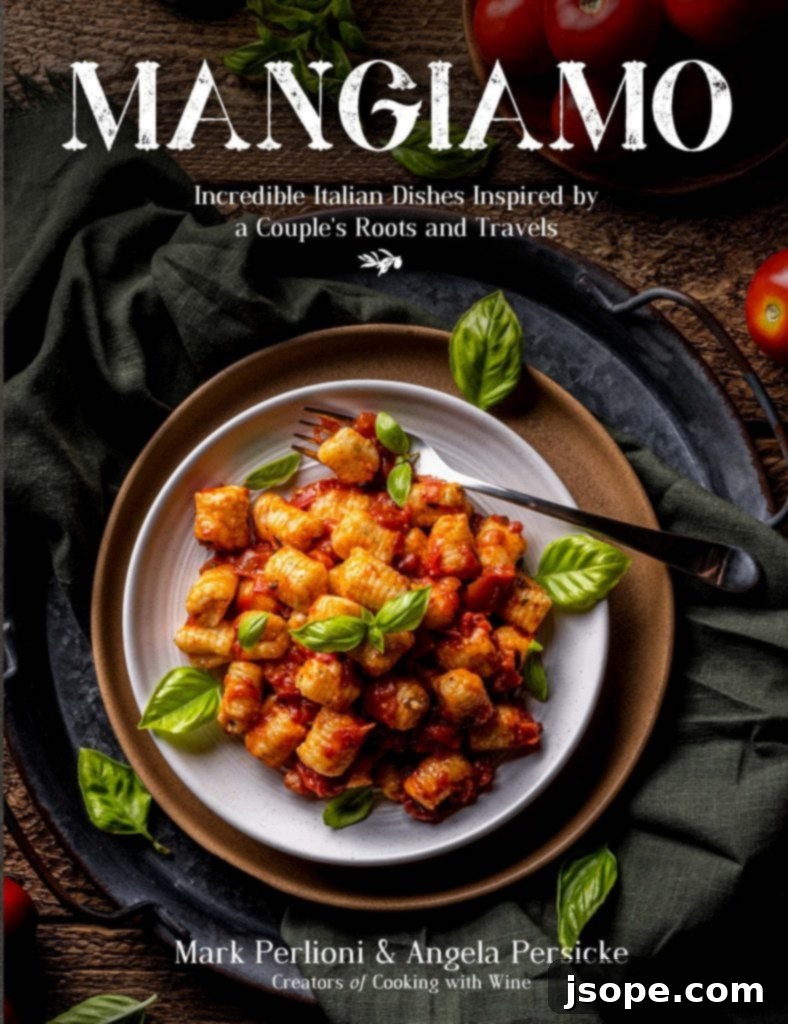
📖 Recipe: Pork and Shiitake Mushroom Ragù

Pork and Shiitake Mushroom Ragù Recipe
A slow-cooked ragù over pasta is one of the most comforting dishes you can enjoy! Here is our cherished recipe for a rich and savory Pork and Shiitake Mushroom Ragù.
Pin Recipe
Ingredients
- 2 lbs pork butt or shoulder (850 g) deboned and fat trimmed
- 1 tablespoon kosher salt (18g)
- ½ teaspoon black pepper
- 2 tablespoon vegetable oil (27g)
- 2 tablespoon tomato paste (28g)
- 2 large stalks celery (100g) chopped
- 2 medium carrots (125g) chopped
- 1 small-medium onion (170g) chopped
- 6 oz shiitake mushrooms (171g) chopped
- 2 tablespoon garlic (20g) minced
- 1.5 cups dry red wine (330g)
- 1 cup beef stock (240g)
- 1.5 teaspoon balsamic vinegar
- 2 teaspoon fresh rosemary (2g) chopped
- 2 teaspoon fresh parsley (2g) chopped
- 2 teaspoon fresh thyme (2g) chopped
- 2 teaspoon fresh oregano (2g) chopped
- 2 bay leaves
- 2 teaspoon whole fennel seeds lightly toasted in a dry pan for 1 min
- ⅓ cup heavy cream (80g)
Garnish
- grated parmesan cheese
- crushed red pepper flakes
- fresh basil leaves
Pasta
- 12 oz dry penne or rigatoni pasta (or 1 recipe Multipurpose Pasta Dough shaped into garganelli or similar)
Instructions
- Preheat your oven to 350°F (175°C).
- Cut the pork into bite-sized cubes (approximately ½ inch or 1.25 cm) and place them in a large bowl. Season generously with salt and pepper, ensuring the pork is evenly coated.
- Heat the vegetable oil in a large, heavy-bottomed frying pan or Dutch oven over high heat. Sear the seasoned pork in batches until beautifully browned on all sides. The goal here is to develop a rich color and flavor, not to cook the pork through. This should take about 3 minutes per batch. Remove the browned pork and set it aside.
- Reduce the heat to medium-low in the same pan. Add the tomato paste and stir constantly for about 30 seconds to deepen its flavor. Then, add the chopped celery, carrots, onions, and shiitake mushrooms. Sauté for 5-7 minutes, or until the onions become translucent and begin to caramelize slightly. Stir in the minced garlic for 15 seconds until fragrant. Pour in the dry red wine and use a wooden spoon to scrape up any browned bits from the bottom of the pan, deglazing it thoroughly.
- Return the seared pork to the pan and cook on medium heat for 5 minutes. Incorporate the beef stock, balsamic vinegar, fresh rosemary, parsley, thyme, oregano, bay leaves, and lightly toasted fennel seeds. Stir well to combine all ingredients, then bring the mixture just to a boil. Remove the pan from the heat, give it another good stir, and ensure the bottom is scraped clean. Cover the pan tightly and transfer it to the preheated oven. Cook for 1.5 to 2 hours. After the first hour, remove the pot, stir, and check the meat for tenderness. Continue to check every 20 minutes thereafter until the pork is exceptionally tender but still holds its shape. If the liquid reduces too much, add more beef stock or water as needed to maintain a rich sauce consistency.
- If you are using fresh pasta, prepare your pasta dough and shape it into your desired form (garganelli, penne, or rigatoni) while the ragù is slowly simmering in the oven. Arrange the shaped pasta on a large baking sheet and set aside until the ragù is ready.
- When your ragù is nearly finished, bring a large pot of generously salted water (approximately 2 tablespoons or 36g of salt per 6-8 quarts of water) to a rolling boil. Add your chosen pasta and cook according to package instructions for al dente, usually 2-4 minutes for fresh pasta or 8-12 minutes for dry. Taste a piece to ensure it is perfectly cooked: firm to the bite but not raw.
- Drain the cooked pasta briefly in a colander, then transfer it directly to a large serving bowl.
- Once the pasta is ready, remove the ragù from the oven. Stir in the heavy cream and cover for just a few minutes, allowing the cream to integrate and slightly thicken the sauce. Taste and adjust seasoning with additional salt if desired.
- Serve the rich ragù generously over the freshly cooked pasta. Garnish with freshly grated Parmesan cheese, a sprinkle of crushed red pepper flakes for a hint of heat, and fresh basil leaves for a vibrant finish. Enjoy immediately!
Nutrition
Carbohydrates: 54g
Protein: 39g
Fat: 19g
Saturated Fat: 7g
Polyunsaturated Fat: 4g
Monounsaturated Fat: 6g
Trans Fat: 0.1g
Cholesterol: 106mg
Sodium: 1419mg
Potassium: 1023mg
Fiber: 5g
Sugar: 5g
Vitamin A: 3802IU
Vitamin C: 6mg
Calcium: 93mg
Iron: 4mg
Tried this recipe?
Let us know how it was!
Do You Love Our Recipes?
We pour our heart and soul into creating delicious and FREE recipes for you here on Cooking With Wine. If you appreciate our content and would like to support our efforts to continue bringing you culinary inspiration, any contribution you’re comfortable with is greatly welcomed.
We are committed to providing you with wonderful recipes regardless, so please know there is no obligation to contribute! Every single contribution, big or small, is deeply appreciated and helps us sustain our passion.
Thank you for being an invaluable part of our cooking community! Your engagement and support are truly what motivate us to do what we do.
